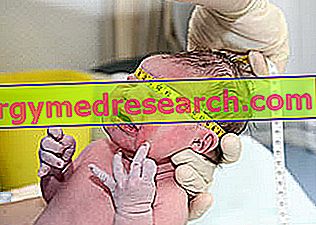Generality
Red stretch marks are signs that appear on the skin surface as lines or streaks that are perceptible to the touch, well defined and separated by stretches of healthy skin. These lesions appear mainly at the level of the belly, thighs, hips and breast. Red stretch marks are due to the breakage of the elastic fibers of the dermis (deeper layer of the skin).

In some cases, red stretch marks are an unpleasant memory of pregnancy, other times they are the consequence of sudden changes in weight . However, the reasons why they occur are not only summarized in these two situations. Among the factors that contribute to determining the appearance of red stretch marks also include poor skin elasticity, genetic predisposition and some pathological conditions, such as obesity, ascites and abdominal tumors.
Red stretch marks are a problem that affects both sexes, although these blemishes are more common in women. Furthermore, in female subjects, there is an early appearance of these signs, especially in conjunction with puberty and pregnancy.
Red stretch marks are considered among the most difficult skin imperfections to manage: although cosmetics, dermatological treatments and specific massages are available, once these signs appear they are almost impossible to eliminate permanently. To tackle the problem correctly, therefore, prevention is essential.
What are
Red stretch marks are distension or atrophic striae, that is, skin marks caused by dermo-epidermal atrophies . In other words, they are real linear lesions, which run parallel to each other, due to the breakage of the elastic fibers at the level of the dermis, the deepest layer of the skin. These "tears" of the skin are transmitted to the overlying epidermis, which takes on a form of streak perceptible to the touch and which represents, precisely, the reddish stretch .
Did you know that…
The color of stretch marks depends on the evolutionary phase : as soon as they are formed they are red-violet in color and barely revealed, to then become, within a few months, pearly and thinner white.
Causes
One of the main causes of the appearance of red stretch marks is the poor elasticity of the dermis . This imperfection begins when the skin is subjected to strong stress: the abrupt cutaneous distension, due to sudden increases and decreases in weight, determines the rupture of the collagen fibers and a traction of the dermis capillaries.
Red stretch marks can appear at any age ; in women, who are affected more than men, they appear between 12 and 30 years, particularly during puberty and pregnancy .
Red stretch marks: what causes their appearance?
From the histological point of view, the red stretch marks derive from a connective damage that occurs at the level of the dermis, associated with inflammatory and cicatricial processes .
The factors that contribute to determining the appearance of this imperfection are numerous:
- In addition to poor skin elasticity, partly related to genetic and constitutional predisposition, the likelihood of red stretch marks appearing increases in all those situations in which tissues are subjected to excessive mechanical traction . An abrupt distension, in fact, can "stretch" the structures of the dermis and favor the breaking of the elastic fibers, as happens in the face of sudden variations in weight that subject the skin to a strong stress, especially if the daily care of the skin is neglected. For this reason, red stretch marks run in parallel lines to each other, perpendicularly to the sense of traction of the forces that stretch the skin.
- The onset of red stretch marks can be favored by the rapid growth and weight changes typical of puberty, ie the developmental phase that leads to changes in points of the body such as hips and breasts. Another condition that predisposes to similar changes in body volumes is pregnancy (to take into account, in addition to the increase in belly volume, hormonal changes). In the latter case, red stretch marks appear above the lower abdomen level, starting from the fourth month of gestation. Similarly, the appearance of imperfections is favored by the distension of the abdomen secondary to pathological conditions such as obesity, ascites and abdominal tumors .
- Even the too intense and repeated stresses affecting the subcutaneous tissue in some sporting activities (eg body-building) can favor small lacerations that, over time, can develop into red stretch marks.
- The development of red stretch marks can also be favored by the use of corticosteroids or anabolic steroids (for the rapid increase in musculature) and by breast augmentation interventions (breast prosthesis application).
The role of hormones in the onset of red stretch marks
In the female sex, a decisive role in the appearance of red stretch marks is represented by the hormonal variations typical of pregnancy, menopause and puberty . In these periods, in fact, some hormones at high concentrations - in particular, the corticosteroids produced by the adrenal glands - reduce the synthesis of fibroblasts and induce atrophy of some components present in the dermis, including elastic fibers and collagen that provide support and skin resistance. The damage manifests itself with skin sagging on the surface, together with the appearance of unsightly red stretch marks.
Hypercortisolism and striae rubra
The presence of cutaneous striae similar to red-purple "stretch marks" ( strie rubre ) is a symptom that is characteristically observed in hypercortisolism (high levels of cortisol in the blood). Unlike real stretch marks (distension striae), these marks on the skin do not tend to lighten over time. The striae rubra are found, more frequently, in association with Cushing's syndrome, ACTH-secreting pituitary adenoma and adrenal tumor.
Symptoms and Complications
Red stretch marks appear as slight atrophic depressions that run linearly, parallel to each other, on the skin surface.
These purplish-red lesions can be more or less thin and are well defined and separated by stretches of healthy skin. The length of the red stretch marks goes from 1-10 mm in width up to several centimeters in length.
The orientation varies depending on the area concerned, since it generally follows the lines of tension of the skin (the so-called Langer lines). The shape can also change: usually, red stretch marks are linear and symmetrical, but can sometimes have jagged and irregular contours .
On palpation, stretch marks have a flaccid consistency and are easily stapled, a clear sign of the loss of skin elasticity that is the basis of their appearance.
Where red stretch marks develop
As for localization, red stretch marks can occur in many parts of the body.
However, in young women, the areas of choice for their appearance are:
- Breasts and buttocks (in these areas, red stretch marks are arranged radially);
- Hips (red stretch marks run vertically);
- Thighs (red stretch marks take on an oblique disposition).
In men, however, these imperfections are present mainly at the level of:
- Arms and shoulders (oblique arrangement);
- Hips (vertical course).
Another site commonly affected by red stretch marks in both sexes is the abdomen.
Red stretch marks: how they evolve over time
- INFLAMMATORY PHASE . At first, stretch marks appear as reddish streaks. The epidermis is reduced in thickness, slowly atrophied and leaving the underlying layer (dermis) visible. In this first phase, the appearance of stretch marks is associated with manifestations of an inflammatory nature. Sometimes, at the site of the onset of the lesion there is a feeling of tension and itching.
- CYCLING PHASE. Within a few months, the erythematous aspect gradually disappears; the lines take on the appearance of depressions that tend to ripple along the longitudinal axis. Stretch marks now have a pearly-white shade, a sign that the blood no longer circulates in the portion of skin affected by stretch marks, just like in scars. Furthermore, the sebaceous secretion stops along the skin depression and the hair atrophies until it disappears.
Diagnosis
The diagnosis of red stretch marks is formulated by the reference dermatologist, based on the history and physical examination. If your doctor suspects increased cortisol production, he may recommend further investigation. The dermatologist can help determine the cause of stretch marks and discuss treatment options with the patient.
Treatment
When the tissue is damaged by the appearance of the red stretch mark it is not possible to go back: the sign is destined to remain, however the situation can be clearly improved by resorting to different treatment options.
Targeted cosmetic treatments
Prevention is the best strategy to avoid the onset of red stretch marks. Once these skin lesions take on a pearly white appearance (definitive scar phase), it is practically impossible to obtain significant and visible improvements with cosmetic products.

Before they form
The cosmetic strategy to prevent red stretch marks must be put into practice especially in the "critical" phases (such as puberty and early pregnancy) and in periods of weight fluctuation .
The specific anti-stretch mark cosmetics are designed to act in a targeted manner on the elasticity and compactness of the skin. This is why they should be used when red stretch marks have not yet formed, with the aim of counteracting their appearance.
The beauty routine must therefore include the daily application of cosmetic products. On alternate days, this practice can be preceded by a light exfoliation that allows the elimination of devitalized cells and impurities, as well as stimulating the skin and making it more receptive to treatment.
How to remove stretch marks when they have just appeared
If some stretch marks have already appeared and it is still red in color, it is important to intervene in the very first inflammatory phase, choosing cosmetic products with intensive, targeted action . These treatments are able to stimulate the regeneration of collagen and elastin, thus limiting the evolution of existing imperfections and making them less obvious.
To mitigate and contrast the newly formed red stretch marks, it is important that the constancy in the application of the treatment does not fail. The product should be applied morning and evening, massaging it transversely with respect to the cutaneous lines, until complete absorption.
Laser and surgical options
Among the methods currently most effective for improving the aesthetic appearance of red stretch marks is the fractionated microablative laser, whose beam produces heat in the area affected by the imperfection, allowing a retraction of the skin (in practice, it is as if the edges of depression reunited, closing the streak). Laser surgery is able to penetrate deeply, going to stimulate the growth of new collagen and thus improve the appearance of the stretch mark, especially if it is still reddish in color, that is, of recent formation. This is possible due to the fact that the affected area is still sprayed with blood and is more receptive to collagen synthesis.
The effects of the laser can also be combined with a radiofrequency system, which allows reaching all the skin layers by stimulating the production of collagen and elastin. This approach allows to obtain results superior to those offered by other methods such as peeling and microdermabrasion . These treatments promote cell renewal: this will ensure that you have a smoother and brighter skin, with less exposure to stretch marks.
If red stretch marks appear below the navel they can be removed during an abdominoplasty operation, while those on the thighs and arms are eliminated by resorting to a facelift in the area .
Prevention
The prevention of red stretch marks is possible by putting into practice habits to counteract them .
These measures act on several fronts and include:
- Physical activity . To prevent red stretch marks it is important to practice regular physical activity: the movement, in fact, not only makes the body tonic and healthy, but also promotes spraying and nourishment of the skin.
- Power supply . The changes in weight put a strain on the elasticity of the skin that is stretched and is released, ending up "tearing"; the greatest danger is when you lose weight abruptly after being fattened just as quickly. To prevent red stretch marks, therefore, it is necessary to take into account the fact that a correct nutrition is fundamental to keep the balance of the balance still and avoid dangerous weight fluctuations.
- Pregnancy . Both during pregnancy and during breastfeeding, the skin is subjected to severe stress. To prevent the appearance of red stretch marks it is possible to apply cosmetics that help maintain skin firmness and elasticity. It should be noted that this strategy may not be totally effective in preventing red stretch marks, but it is important to guarantee the skin the best hydration during the rapid increase and the equally rapid emptying of the body volumes. Treatment is useful, in particular, before the fourth month of pregnancy and after giving birth for at least another three months.
- Stress . The prolonged physical and mental fatigue conditions favor the production of cortisol, hormones able to subtract skin tone and promote red stretch marks.



